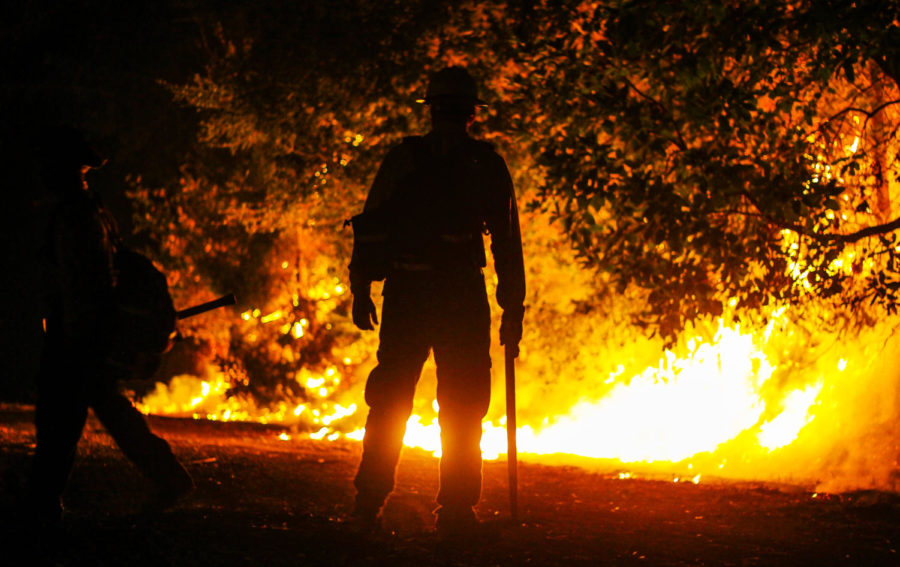Community leaders did not mince words when they talked about the scope of the wildfires endured by the Sonoma County and Santa Rosa Junior College communities the week beginning Oct. 8.
“There’s never been a bigger fire, a more destructive fire or a deadlier fire in California,” Santa Rosa Mayor Chris Coursey said. “We’ve seen some whopper fires but this was bigger than them all.”
Santa Rosa Junior College President Dr. Frank Chong said, “The impact is deep. It’s heavy and it’s going to be for a long time.
Although the fires are nearly extinguished, the long road to recovery for the college and the wider community has only begun. Whole communities were evacuated and residents of Sonoma County breathed in an atmosphere of smoke and fear for more than a week. Some are just now returning home, while others sift through the charred remains of their lost homes.
A vision of the challenges in the days ahead becomes clear as campuses and businesses reopen and Sonoma County residents attempt to regain some semblance of normalcy.
The ‘Bear Cub family’
Since the first day of the fires, SRJC’s Emergency Operations Center (EOC) has been handling the college’s response and decided to close the campus until Oct. 22 following an initial two-day closure on Oct. 9.
College officials have been doing everything possible to assist students and encourage them to complete coursework as the semester resumes.
The two-week campus closure forced faculty of each discipline to find ways to cut what they could from course material while still providing students with the skills and instruction needed to fulfill state educational requirements.
“We’re adjusting everything as we go,” said Mary Kay Rudolph, dean of instruction. “Our number one rule is no harm can come to students. We cannot ask more of them just because we have less time.”
The Student Government Assembly (SGA) expanded funding for its food pantry, created the Fire-Relief Comfort Zone in Bertolini Hall on the Santa Rosa campus and will continue to advocate for undocumented students who don’t qualify for federal disaster relief aid.
“SRJC is a family. We’re a Bear Cub family,” SGA President Evelyn Navarro said. “It’s our duty as SRJC faculty, staff and students to make sure our community is well-taken care of in this time of need.”
Navarro praised the work of faculty in the Student Affairs and Student Equity offices but emphasized the need for unity in the difficult times ahead.
“We are going to bend over backwards to make sure students can do what they need to do to get through this semester,” said Ellen Maremont Silver, SRJC director of communications. We’re not giving up on this semester. We’re all in this together.”
SRJC President Dr. Frank Chong said, “I hope students understand that this is a once-in-a-lifetime catastrophic event, so it’s not business as usual, and even when we come back, it won’t be business as usual.”
The wider community
The rebuilding process will be coordinated between local, county, state and federal governments. Santa Rosa Mayor Chris Coursey estimates the cleanup process will be completed by Feb. 2018 and will include the Environmental Protection Agency and the Army Corps of Engineers.
The city and county governments will likely lose revenue in taxes due to loss of property, businesses and tourism, but the total economic impact will remain unclear until formal assessments are done.
Before the fires, the county boasted a booming economy with only a 4 percent unemployment rate. Shirlee Zane, chair of the Sonoma County Board of Supervisors, encouraged residents to take advantage of local assistance centers providing access to local, state and federal disaster loans.
“The Small Business Administration (SBA) has disaster loans available to individuals and business to replace damaged property,” she said. “It’s really important we do an economy-related recovery and get people resources as soon as possible.”
Zane says the displacement of employees will cause a dip in our economy but job-seekers can use Sonoma County Job Link to find employment.
The county is granting emergency tax allowances to the cannabis and tourism industries, both of which were hard-hit by the disaster.
Al Lerma, Sonoma County director of business development said, “I think there is a perception that Sonoma County is not open to business because the damage looks so much more extensive in the media. The county will have to reach out to let tourists know we are open for business.”
No vacancy
The fires destroyed roughly five percent of residences in Santa Rosa, reducing supply in an area already suffering through a housing crisis.
“It’s pretty stark,” Coursey said. “We had a housing crisis two weeks ago and now we have 3000 fewer houses in the city. It may be exacerbated in the coming months as people come in for debris clean up and construction.”
Countywide, the number of homes lost climbs to 4,000 with approximately 10,000 people currently displaced.
Rebuilding may begin as early as next spring and some commercial properties may be rebuilt as multi-family housing complexes.
The Federal Emergency Management Agency (FEMA) will provide 500 intermediary housing units in the coming months, with trailer units expected to arrive in four weeks.
Coursey said that the housing crisis is particularly difficult on students and said the city and county will continue efforts to make housing more affordable.
On Oct. 24 the Sonoma County Board of Supervisors adopted two measures designed to make existing housing stock available to those who lost their homes. The measures loosened residential housing regulations and restricted the issuance of new vacation property rentals. The district attorney intends to prosecute landlords guilty of price-gouging in an attempt to profit from the disaster.
“We’re turning over every stone,” Zane said.
The love in the air is thicker than the smoke
Mike Grabowski, SRJC Administration of Justice faculty member, recently traveled to Newtown, Conn. and Columbine High School as part of a sabbatical project about community resilience, or how communities collectively heal from tragedy.
Grabowski said Santa Rosa should try to return to life as it was before the fire and individuals should take advantage of support services.
“Sometimes it’s human nature for people to be hesitant asking for help but they shouldn’t be. A community went through this, not just one person,” he said.
Despite Grabowski’s worries about long-term effects on adolescents and first responders, he believes individuals and communities can be strengthened through tragedy.
“Sometimes people don’t realize their strengths until they’ve faced adversity,” he said. “We are resilient by nature. Each of us must work on finding and keeping that resilience in our own way; sometimes with the help of others, sometimes from those we least expect.”
Behavioral Science instructor Brenda Flyswithhawks, who led attendees in a Native American prayer at the SRJC Fire Relief event Oct. 19, is optimistic about the future of the county and college.
“We’re gonna rebuild this,” she said. “We’re gonna rise right out of these ashes and we’re gonna be bigger and better from it.”





